Eating and Drinking Out in ANTEQUERA
There is no shortage of venues, choice of ambience, and style of eating in Antequera.
There are over 100 Restaurants, Cafés and Bars. These classifications should be interpreted liberally as most restaurants offer a café and bar service, and cafés and bars will offer basic food.
Also, there are more than a dozen Pubs, including the late night bars centred in the Calle Calzada area, which stay open to 04:00, or later in the busy periods.
Check out our Restaurants in Antequera section to see a brief guide of recommended restaurants for eating out in Antequera.
Opening Hours
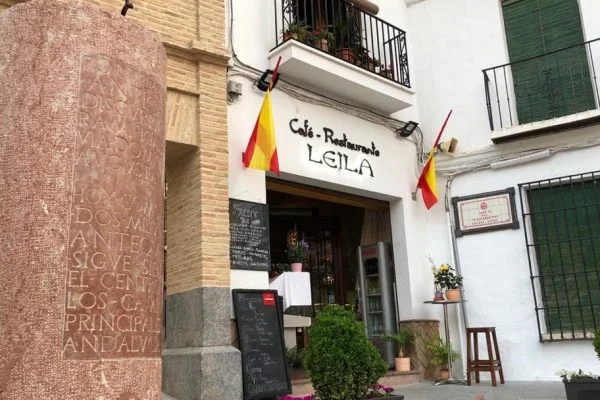
Restaurants
The opening hour for restaurants is between 12:00 -13:00.
They will usually serve cold tapas as soon as they open.
Hot tapas from the kitchen are then available after 13:00.
Table dining will be à la Carte, and often the Menú del Día (see below).
Kitchens are usually serving lunches by 13:00-13:30, and will close around 16:00.
Evening dining is commonly from 20:00 onwards.
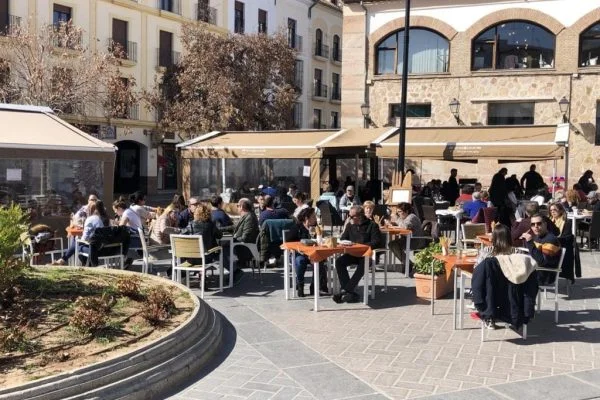
Cafés/Bars
Opening hours vary for the cafeteria/bars, but most are open by 08:30, serving sandwiches, molletes with toppings, and some pastries, in addition to coffee, tea, hot chocolate, soft and alcoholic drinks.
Some open before, catering for early start workers, with breakfast snacks, coffee or tea, and perhaps a copa (small wine/liqueur glass) of anís, whisky or brandy.
They will usually be open throughout the day, and close around 20:00.
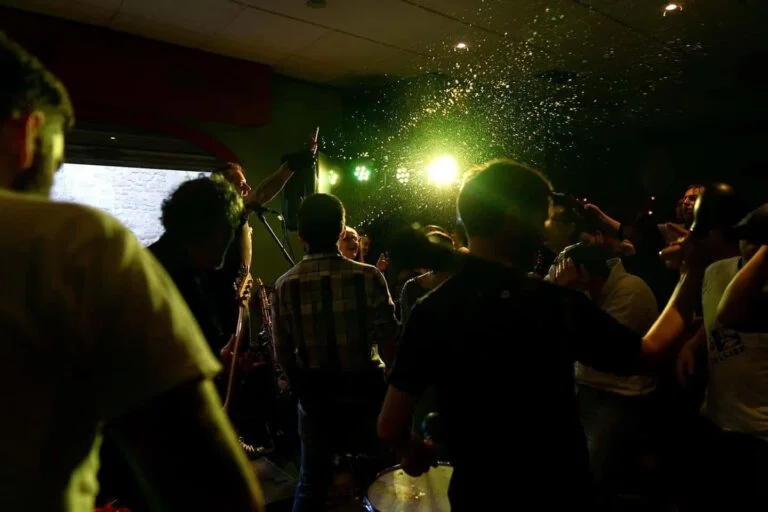
Pubs
Opening hours, depending on the day, tend to be from early evening continuing into the early hours of the morning.
The pubs in Antequera are an Andalusian interpretation of the UK pub.
They cater more for the younger market, though sometimes populated by middle aged groups. Loud music, large screen TV’s, and usually young bar staff are the norm.
Thursday, Friday and Saturday nights you will likely find them full (and loud!).
Drinks may be served with crisps or nuts, but no tapas.
Spanish Style Eating Out in ANTEQUERA
The Tapa
The concept of tapas lies at the core of Spanish eating culture.
In food terms, the word tapa – in effect, though not literally- means a small food sample.
It is classically served in a saucer sized porcelain dish. Alternatively, it will come in a small glazed terracotta dish (casuelitas). Some of the trendier venues now use small two handled metal dishes, or glass bowls, embellished with small accompaniments to accentuate a ‘gourmet’ flair.
Classic tapas are available virtually everywhere (with the exception of Pubs). They are normally for eating at the bar with a drink, or sometimes served to the table, depending on the venue.
A selection of tapas will likely be displayed at the bar in a glass temperature modulated cabinet. These are cold tapas, or dishes ready for heating. There will usually be an additional wall mounted blackboard, or bar menu, of the full list of kitchen prepared tapas on offer.
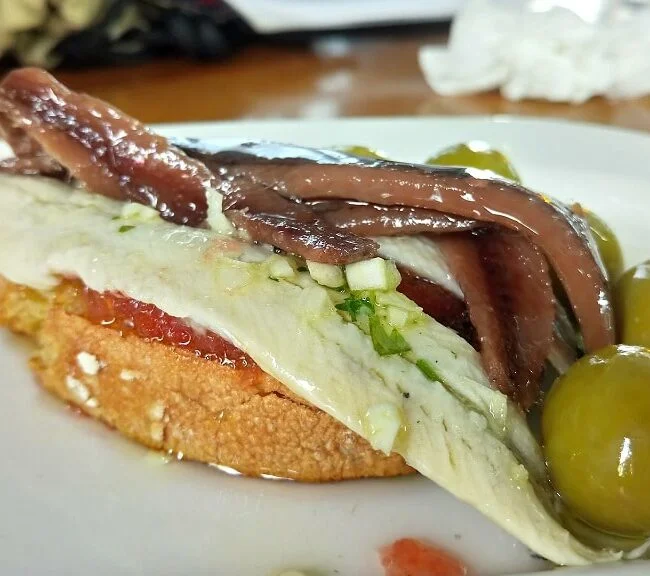
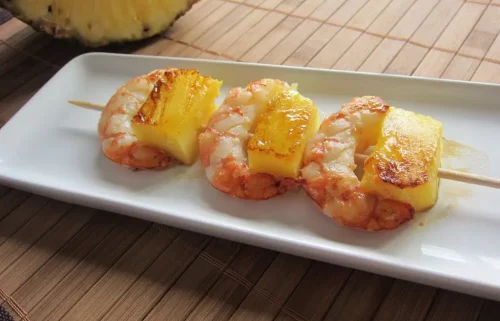
Pinchito
Within the Tapa category, but sometimes denominated separately, are pinchitos. These are mini skewered kebabs of meat (commonly pork), fish chunks, or seafood.
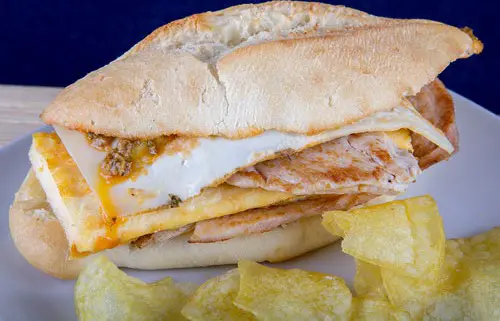
Montadito
Also, montaditos: a small toasted bun, hamburger style, with any kind of meat, or a fish fillet such as tuna.
Origins of the Tapa
There are differing versions of how the Tapa originated.
1. The Castilian King Alfonso X unwittingly invented it. When advised by his doctors to cut back on his food intake, he instructed his cooks to serve smaller portions of food, with more variety. This style of eating was liked so much by the royal court that it became the precursor of the ‘tapas’ culture.
2. The Spanish word ‘tapa’ actually means a small cover (top), of something otherwise exposed to the air. The Andalusian version is that historically, during the hot months, customers would habitually place a small dish of olives on top of their glass of sweet wine or sherry, in order to keep the flies off. Over time the small dish became the staple container for any food served at the bar, and the term ‘tapa’ remained.
3. However, probably the most likely version is that the Moors originated the concept of small dish eating during their reign in Andalusia. It is within their gastronomic culture to serve lots of small dishes of various foods, as a symbol of hospitality.
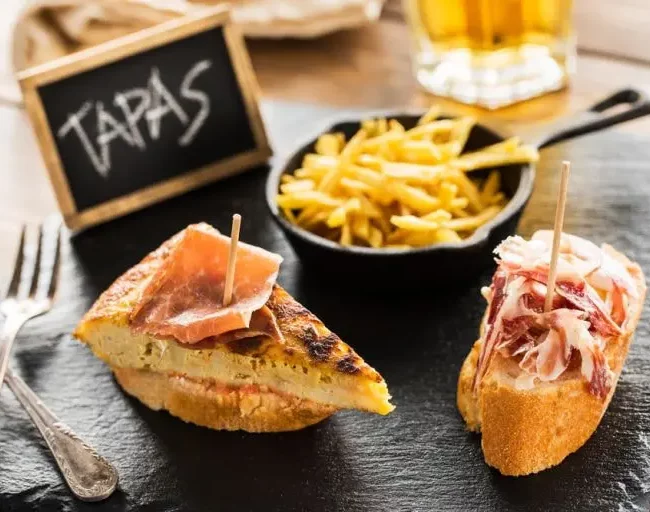
The tapas style of eating is also reflected in the ‘meze’ (multi small dish dining) in Greece, Turkey, and North Africa.
Whatever the origin, it is a very cost effective way of eating out in Antequera, if not seeking a table meal. It is also a nice and informal way to enjoy a few tastes, a drink, and a chat.
Note: Antequera has it’s own Ruta de Tapas (tapas route) celebration over the last week of February and first week of March. Some fifty restaurants create their own special house tapa, which is offered to the public with a glass of beer or cider for 3 euros. A map is published by the Ayuntamiento (council) featuring photos of all the tapas, with location references for each restaurant. If you wish to check out the latest article, you can click here.
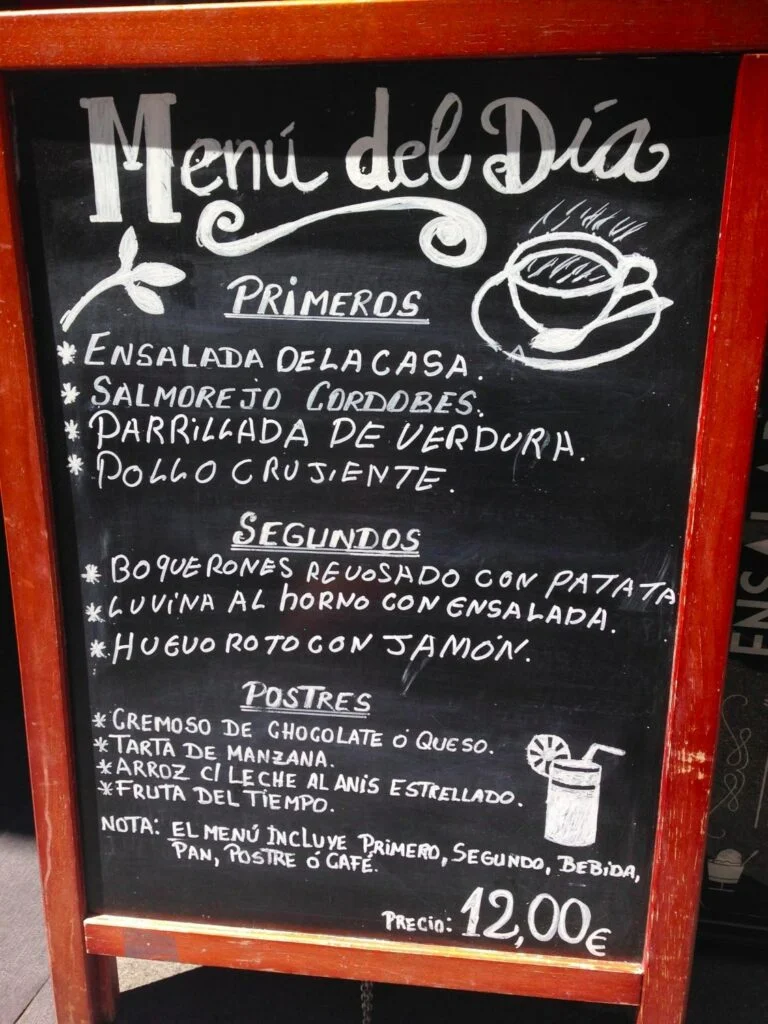
Menú del Día (Menu of the Day)
Most restaurants offer a Menú del Día. This is a budget priced, three course lunch, including bread and a drink. There is usually a minimum choice of three starters, main courses, and deserts.
The concept originated to provide the working man with affordable sustenance at lunchtime. You often still see in the popular informal venues, groups of men fresh from the building sites, squeezing in this substantial meal at speed during their lunch break!
The Menú del Día, has of course, long since become an established feature of any pavement blackboard, luring hungry and bargain seeking tourists to the table. Quality varies, but a good Menú del Día offers unparalleled value, if you can manage a three course lunch.
Raciones in ANTEQUERA
Raciones are a plate size serving of a single food of your choice e.g. ham, cheese, chorizo (sausage), fish varieties, chicken, pork or beef, served on it’s own without chips (patata fritas) or vegetables (verduras). Most restaurants offer raciones and a ‘media’ ración, which, as implied, is a half plate size, usually at slightly more than half the cost.
Raciones offer an economical and pleasurable way to eat out in Antequera if you don’t want a full blown meal. Or, if you want to try several dishes, and put all in the centre of the table to share (compartir), raciones are ideal. This is a common way of eating in Antequera.
There are often offers (ofertas) advertised, which include a bottle of wine. E.g. a ración of ham and a bottle of Rioja for less than the normal combined price.
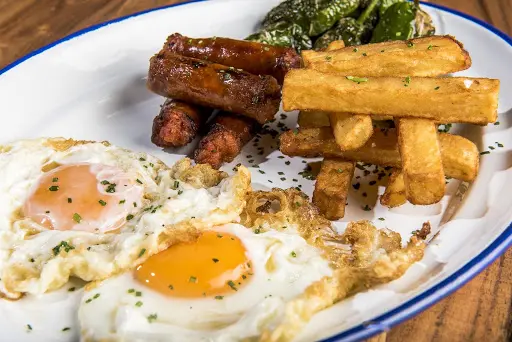
Combinados in ANTEQUERA
This basically means a main course with vegetables or chips on the plate (combined). This term is now not always used on menus, and will tend to feature in long established restaurants using old vernacular.
Comments
The concept of hot dining plates (platos calientes) is anathema to most restaurants. In the more expensive venues you can ask for them if desired (we do without embarrassment), but in the more everyday dining places it would not be normal.
The deep fat fryer is an essential cooking tool in all Andalusian kitchens. In addition to chips, fried battered fish and seafood are prevalent on Antequeran menus, as are croquettes (croquetas) with various fillings.
A la plancha means cooked in the frying pan with just a little oil, or on a flat gas fired hot plate. It is the Spanish method of grilling.
Al horno, means oven cooked.
A Note on Wines

In Andalusia, red wine (vino tinto) is often drunk cold in the summer, although it is also enjoyed at room temperature (al tiempo).
Historically, if you went into a bar and asked for a glass of white wine (copa de vino blanco), you would be served manzanilla, or what we know as dry sherry. Even now, some of the older bars in Antequera only stock manzanilla as their white wine, served in a sherry glass.
A brand called Barbadillo then came onto the market as a non fortified white wine, and pretty much became the only white wine on offer other than manzanilla, for some time.
In Antequera the range of white wines is now much more diverse.
Thankfully too, in Antequera, white wines are now being served chilled, which was not always the norm until the last decade.
If you want your wine (white or red) cold, ask for it frío (pronounced freeo). If you wish for it to be room temperature (red), request it al tiempo.
Depending on the quality of the restaurant, a house wine is priced between 10 and 13 euros. On the coast expect between 12 and 15 euros.
Tipping when Eating Out in ANTEQUERA
The 10% tipping ritual in the UK for example, does not apply in Spain, unless you wish it to. Locals will classically leave the loose change from a cash payment for the bill.
We tend to leave a tip (propina) relative to the level of service we feel we have received, rather than to a percentage. Basic wages are low here, and staff, by and large, work hard.
Any tips go into what in Antequera/Spain is termed the bote. (The nearest translation is bottle). Usually cash tips in the bote are pooled between the waiters and waitresses on the shift. Commonly you will hear a bell ring whenever a contribution to the bote has been made.
If you add a tip to a credit card payment it will go to the restaurant. You may prefer to leave a separate cash gratuity if you have enjoyed good service by a waiter (camarero) or waitress (camarera).
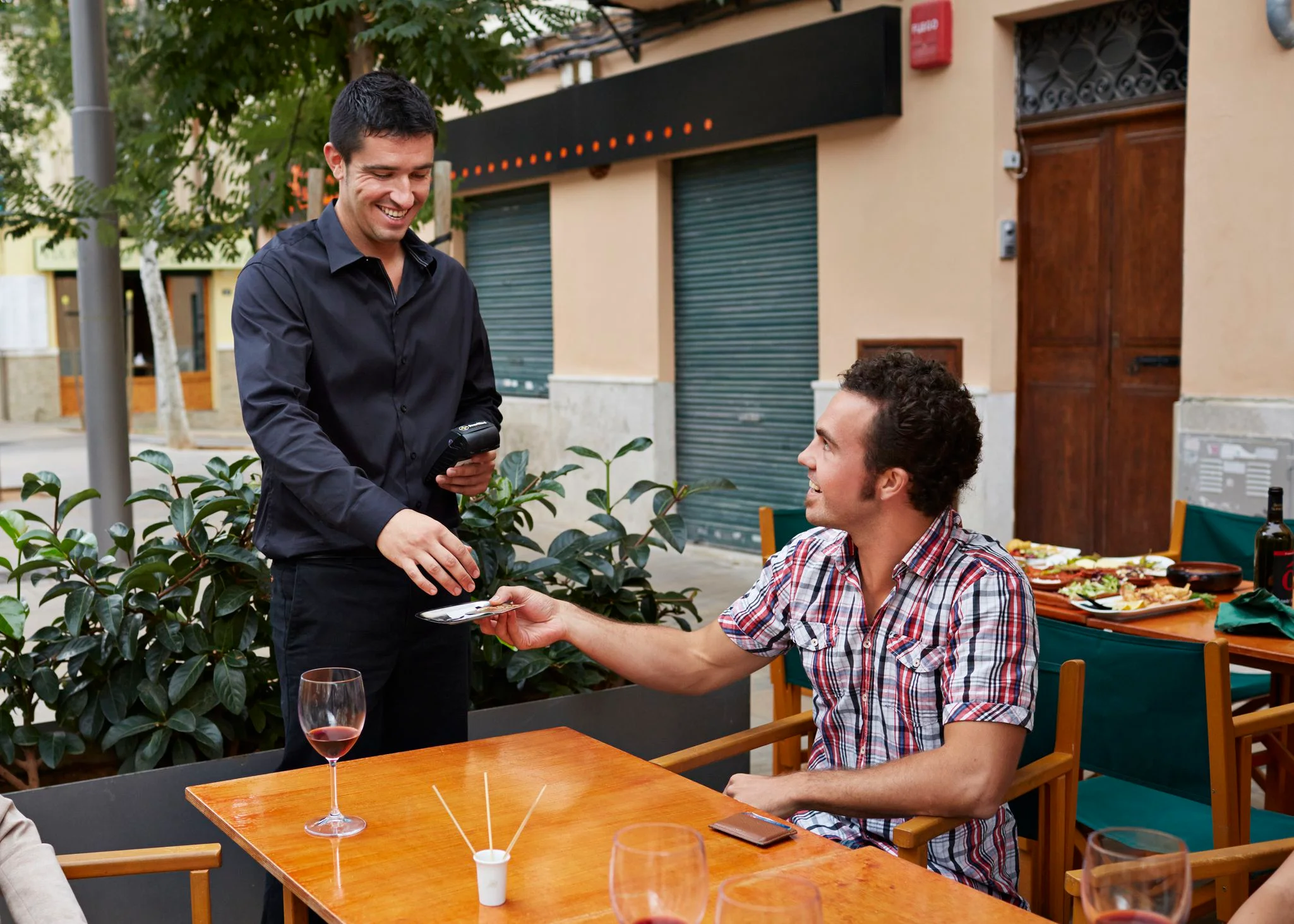
Pricing in ANTEQUERA
In the larger cities, such as Malaga, Seville and Granada, location will have a bearing, with the tourist areas inevitably more expensive.
Antequera does not have a tourist area.
Prices here vary according to the standard of cuisine, ambience, and nature of the restaurant.
Most of the restaurants are well priced in line with the product offering.
Dining out in Antequera is not expensive. This is bourne out by the large number of Antequeranos who frequently dine in restaurants, in combination with cooking at home.
Al Fresco in ANTEQUERA
In Antequera virtually all restaurants have terraces (or a rear garden), for al fresco dining, snacking, or just drinking.
Food Vocabulary Guide for Eating Out in ANTEQUERA
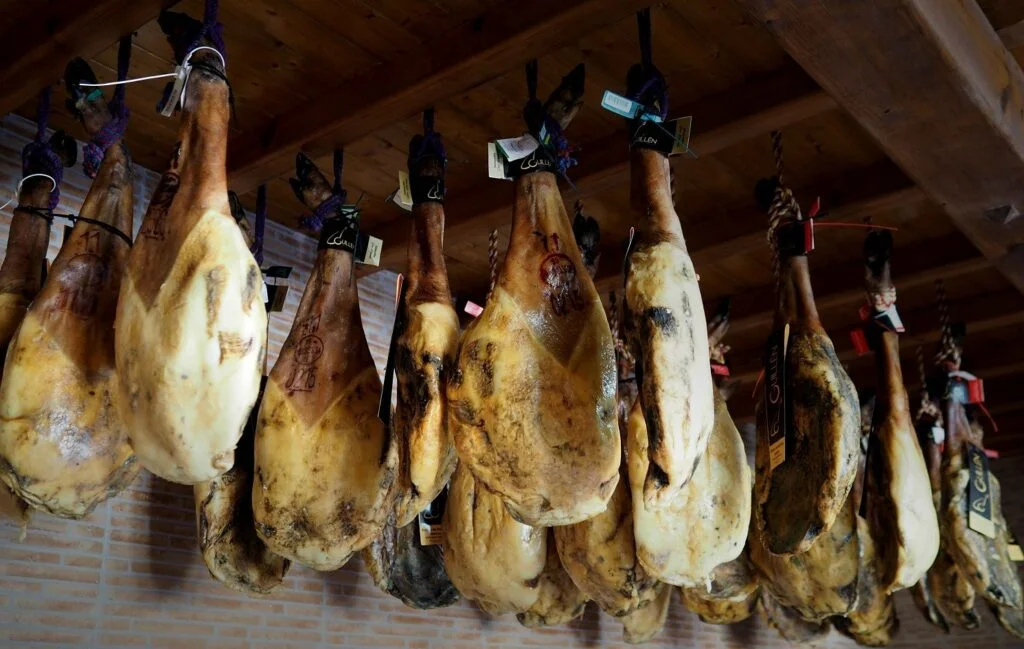
Ham
Jamón york , ó cocido – processed ham. It is served in molletes, or a bocadillo (sandwhich), in a baguette form, or with toasted sliced bread (pan tostado).
Jamón serrano – Spanish ham, a little like palma ham. It is air cured from white pigs. The word Serrano is derived from the word sierra, which means mountain range. It is produced in several of the Andalusian mountain ranges.
Jamón ibérico – The best of Spanish ham. It comes from the Iberian pig, or ‘black pig’. These live, and are reared, mostly in the forests of Extremadura. The staple diet of the Iberian pigs is roots and acorns. Jamón ibérico is finely marbled with fat, and creamier in taste than jamón serrano. It is also more expensive, but worth the premium.
Please refer to our guide on hams for more information.
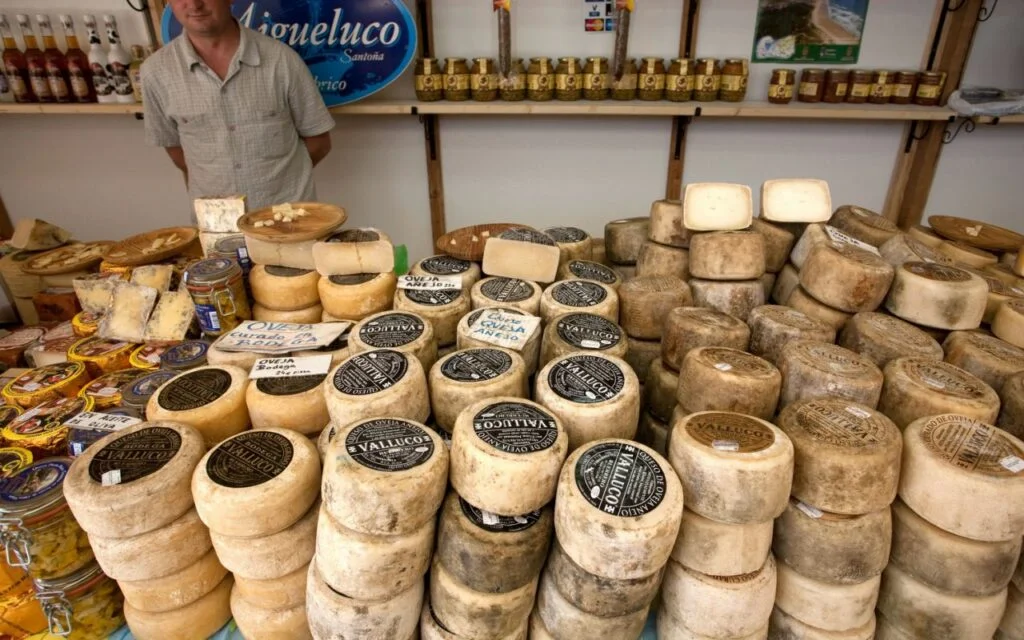
Cheese
Queso – cheese. Classically served in triangles on a round plate. A queso viejo (aged) has a strong aftertaste, and can be crumbly.
A queso curado just means cured, and is milder on the tongue.
A platter of cheese is surprisingly expensive in restaurants. It is a lovely central dish however, accompanied by a robust red wine.
Please refer to our guide on cheeses for more information.

Vegetable Dishes
Verduras – vegetables. Verduras mixta (mixed vegetables), or verduras verde (green vegetables) may be served in place of chips in some restaurants in Antequera.
Judías verdes – green beans. Served boiled, though rarely al dente.
Patatas pobre – sliced potatoes cooked in a delicious broth and onions. Literally the name means ‘poor potato’. A good option everytime if you are fed up with patatas fritas!

Egg Based
Huevos – eggs. As explained above, a revuelto is a mix of eggs with various additives. Espárragos (asparagus), pimientas (peppers), jamón, and cebollas (onions), are common. Boiled egg is huevo duro (hard egg), which is a common ingredient in ensalada mixta.
Tortilla – the much loved Spanish omelette. The base, of course, is huevos. It is classically made with boiled cubed potatoes, but it can be made with a whole variety of ingredients. Tortilla is cooked very thick, and served in sliced portions like a cake. It is a lovely tapa.
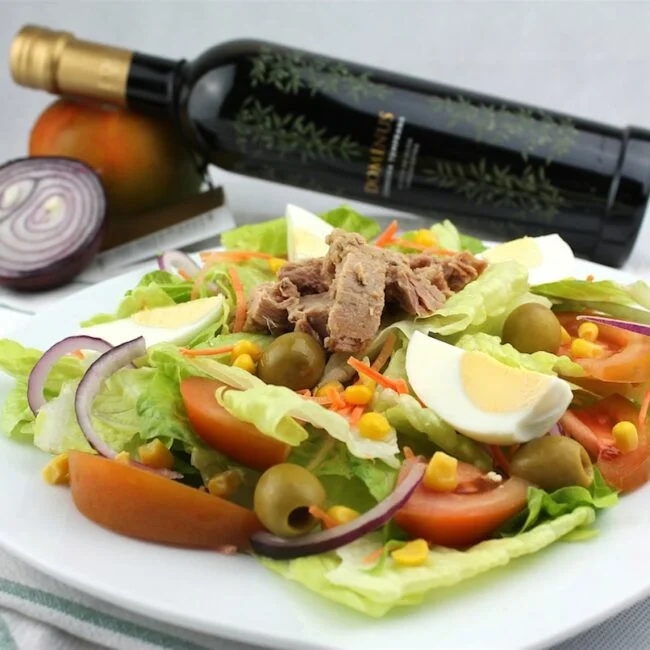
Meat and Poultry
Filetitos – thinly sliced pieces of either pork (cerdo), or chicken (pollo).
Solomillo – fillet of beef (tenera) or pork, or salmon.
Entrecot – sirloin of steak or pork.
Chuletón – rib eye of steak.
Pato – duck. Duck is rarely on the menus in Antequera, and also rarely purchasable in supermarkets or butchers. Thus, it is a bit of a delicacy here.
Conejo – rabbit. This is usually served chopped up in a rich stock. Boney, but scrumptious!
Pierna de cordero – leg of lamb.
Chuletas de cordero – thin lamb chops.
Pollo plancha – pan cooked sliced chicken breast.
Pollo empanada – sliced chicken breast pan fried in bread crumbs.
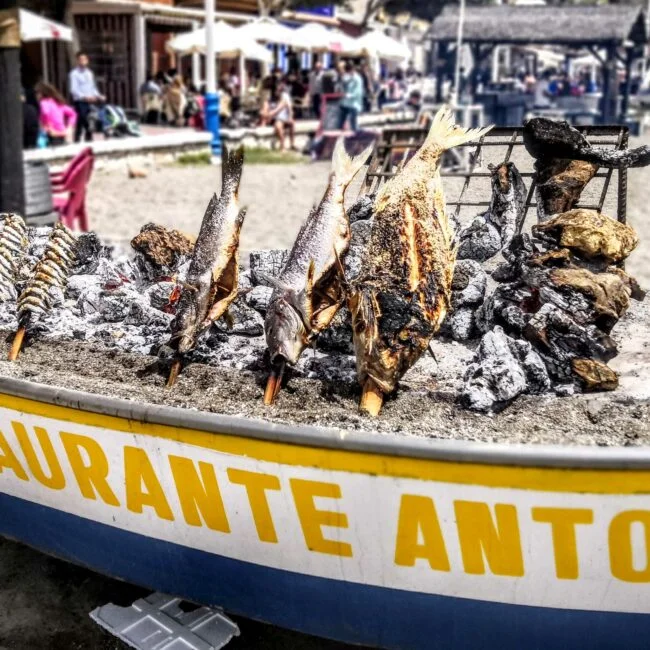
Fish
Rosada – cod, cooked either fried in batter (frita), or pan grilled (plancha).
Merluza – hake, cooked either fried in batter (frita), or pan grilled (plancha).
Lenguado – sole. Usually served pan grilled, or fried in bread crumbs.
Lubina – sea bass. A flavourful fish which can be cooked in the oven or pan grilled. It can be served whole or filleted. It is sometimes offered a la Sal, meaning baked in a casing of salt. This will be wheeled to your table on a trolley. The waiter will then break up the salt casing and fillet the fish, in ‘silver service’ style.
Sardinas – sardines. Sardinas in Antequera will be plancha’d on a hot plate, or in a grill pan.
Note of interest: If visiting the coast these are served as a skewer of several sardines (espeto) barbecued, cooked against wood charcoal, with the skewer speared into a sand base, a few inches from the heat. The bar/restaurants on the beach (called chiringuitos), often have a cook designated solely to barbecuing espetos, and other barbecuable fish, in a designated area to one side of the chiringuito.
Some of the large restaurants on the outskirts of Antequera, termed Ventas, often have grand sized barbecues (brasas), and sardines will be grilled, as espetos, in quantity for large groups.
Sardinas are a delicious and economic fish dish.
Dorada – gilthead bream. Like lubina, it is common on good menus. It tastes less rich than lubina, and is slightly more meaty. The same methods of cooking apply. It is also ideally suited to the coastal barbecuing approach as an alternative to espetos.
Note: Menus in Antequera are increasingly being offered with translations into English, French, and German.
Menu Terminology in ANTEQUERA and Andalusia
In restaurants the menu is called a carta (literally, it means a letter). (A wine list is a carta de vinos, or lista de vinos).
If you ask for the ‘menú’ this can be interpreted in Antequera as enquiring about the menú del día. The word ‘carta’ is explicit.
In the cheaper restaurants you may have to request the wine list.
All types of meat, fish and seafood are available in Antequera.
These are classically offered fried (frita), grilled (plancha), or oven cooked (al horno), according to the particular dish.
Stocks and sauces are prepared in cauldron style pots, to accompany dishes where appropriate.
Chips (patatas fritas) are often served as a standard accompaniment.
Sugerencias (del día). Suggestions (of the day).
If promoted on a blackboard, or a flyer at the table, the sugerencias will likely be made from fresh produce just delivered.
If the sugerencias are featured as part of a printed menu, the dish or dishes may be the resident chef’s speciality.
On the coast sugerencias tend to carry a price premium. In Antequera this is not usually the case.
Starters (Entradas)
An extensive list of starters is usually available.
A mixture of meat and fish will be offered. Also soups and salads.
(Note: on Mondays, in Antequera, only frozen fish will be available. The fish market in Malaga is closed on Sundays, so fresh fish cannot be collected or delivered for Monday).
The list of entradas on offer differs by restaurant, but some classics are:
Fish / Seafood
Calamares – squid fried in batter or grilled
Boquerones – fried anchovies
Atún plancha – tuna pan grilled in oil
Rosada rebozada – cod pieces fried in fluffy batter
Merluza frita – hake pieces fried in batter
Langostinos rebozada – large prawns fried in fluffy batter
Meats
Lomo salsa tomate – pork pieces in a herby tomato sauce
Lomo ajo – pork pieces in a garlic broth
Carrillada – pigs cheek. A soft and tasty delicacy
Ternera en salsa – boiled beef in a sauce of the day
Salchichas – thin boiled sausages in a stock
Asadura – liver pieces in a herby tomato sauce
Salads
Sometimes a large mixed salad (ensalada mixta) is shared as a dish for the centre of table. This is either a pre-amble to the main course, or an accompaniment to other individually chosen starters. The ensalada mixta comprises a mixture of salad leaves, onion, tomatoes, sweetcorn, boiled egg, and tuna. There is usually a choice of salad entradas, such as ensalada rusa (‘Russian’ salad, with potato, tuna, peas, and mayonnaise).
Olive oil and vinegar will be provided separately for you to dress the salad.
There is usually a variety of salads offered, with different combinations of ingredients and dressings.
Main Courses (Platos Principales)
In Antequera, the main course section of the menu will be broken into the usual subsections, according to food type.
Carnes = Meats
Pescados = Fish
Mariscos = Seafood
Ensaladas = Salads
Note: These subsections may contain further sections.
Carne a la brasa = Meat grilled on a hotplate or barbecue
Carnes con salsa = Meats with a sauce
Parrillada means barbecued. Normally a parrillada dish will contain a mixture of meats, such as steak, pork chops or fillets, sausage. A parrillada dish should be enough for two. I have however, seen some well built guys consume one for themselves!
Pescados fritos = Fried fish (always in flour or a batter)
Pescados a la plancha = Pan grilled fish
Pescados con salsa = Fish cooked in a sauce
Depending on the restaurant, main courses will almost always include the starters in a larger portion. A likely accompaniment is chips, with a small portion of salad or vegetables, on the plate.
An example of other dishes to be enjoyed include:
Ternera entrecote – sirloin steak pan cooked
Ternera filete – fillet of steak
Cordero pierna – leg of lamb
Cochinillo – suckling pig
Lomo Secreto – a fatty rich cut of pork
Lomo solomillo – pork fillet pan cooked
Lubina al sal – bass baked in a salt casing
Salmonetes plancha – small red mullets pan cooked
Lenguado plancha – sole pan cooked
Salmón en salsa – fillet of salmon in a cream and stock sauce
A variety of additional sauces will be offered according to the dish.
Paella
No insight to eating out in Antequera, or Spain for that matter, would be anywhere near complete without mentioning what is probably Spain’s most famous dish: paella.
Paella is not always on the menu in many restaurants in Antequera, due to the preparation time involved. A lot of the restaurant kitchens in Antequera are quite small, with the kitchen staff cramped and busy.
To prepare a good paella the cook needs knowledge, space, and time.
Hence, in Antequera, paella is often only offered on a Friday lunchtime, and sometimes Sunday lunchtime.
There are some restaurants that have it permanently on the menu, but you will need to order well ahead of serving, and there will be a minimum of two people required to eat it. No restaurant will prepare paella from scratch for one person.
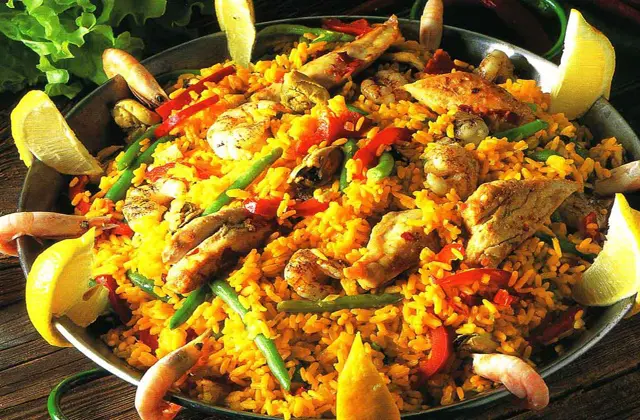
Origin
Paella originated in Valencia.
Valencia’s huge rice fields, outside the city, in the flat marshland criss crossed with irrigation channels, is one of the most famous rice growing areas in Europe. The paella, which is Valencia’s national dish, was born here.
Agricultural workers prepared a fire at lunchtime, and cooked rice in a flat pan. They added whatever they could find to the rice. Initially it was snails, and vegetables. Later, on special occasions, snared or shot wild rabbit was added. Then chicken too, was a familiar ingredient.
These days paella marinera is a favourite, which is paella rice with fish and seafood. Also, paella mixta, which combines fish, seafood, meat and poultry.
Paella, historically, could also include liver and blood sausage. (The people who condemned Jamie Oliver for his recipe of paella with chorizo didn’t know their history!).
It is traditionally served to the table in the black metal dish it was cooked in.
On festivities, paella is often prepared and cooked in bulk, in massive paella pans (up to 1.5 meters diameter), and served as tapas to the masses.
Whilst in Antequera, if you see paella advertised on a restaurant terrace blackboard as ‘hoy hay paella’ (today there is paella), get in quick before the locals devour it!
Vegetarian Eating Out in ANTEQUERA
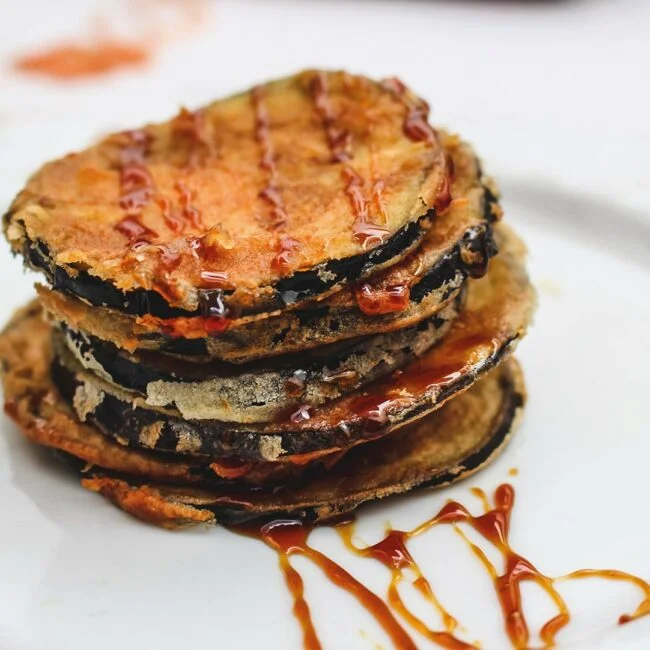
Antequera, like the rest of Spain, is slowly evolving in terms of vegetarian options on a staple menu.
Restaurant owners are becoming more receptive to vegetarian requests, and can usually adapt. Just ask.
However, apart from ordering a fresh salad, free of fish or fried bacon pieces, there is a dish called revuelto.
Revuelto means scrambled.
When applied to eggs, you have the basis for many dishes.
Revuelto is almost always on offer as part of the menu, and comes with all sorts of added ingredients. You can request the inclusion, or exclusion, of whatever you wish.
A revuelto cooked with asparagus, for example, is a nice option.
Aside from revueltos another choice is fried thinly sliced aubergine (berenjenas). Accompanied with honey (miel) dripped over the dish, it is a tasty finger picking option. In Antequera it is commonly available either in tapa form, or as a starter.
Desserts (Postres)
The Spanish have a sweet tooth, and Antequera is no different.
There are any number of pastry, cake, and ice cream offerings. All of these can be served lavishly decorated in sauces.
Cream will be the rather sugary type, squirted from an aerosol in pretty shapes.
If you would like a pastry, cake or ice cream without the trimmings, ask for the dessert sin salsas y crema (without sauce and cream).
Fruit is also an option. A slice of water melon, a banana, or apple, may be included in a menú del día.

